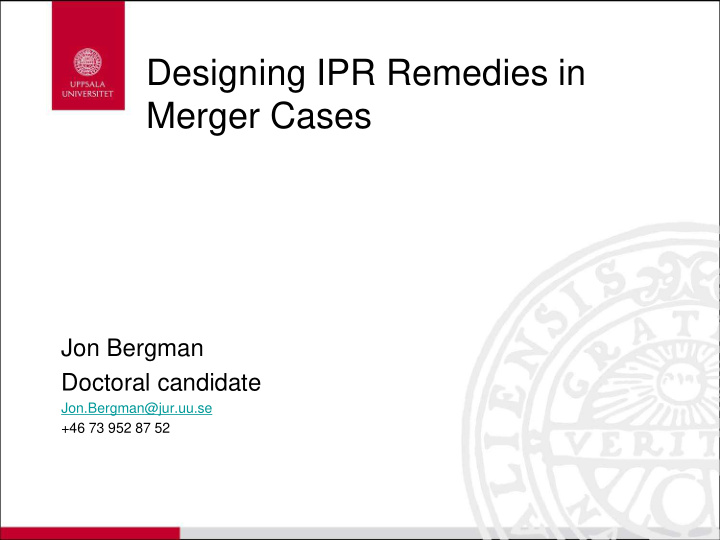



Designing IPR Remedies in Merger Cases Jon Bergman Doctoral candidate Jon.Bergman@jur.uu.se +46 73 952 87 52
1. INTRODUCTION 1. Introduction 2. On my research 3. Designing IPR remedies – General framework 4. Designing IPR remedies – Further considerations 5. Concluding remarks
2. ON MY RESEARCH • Analyzing EU Merger Law – Council Regulation (EC) No 139/2004 of 20 January 2004 on the control of concentrations between undertakings (the ‘ EUMR ’) • Special Focus: – TMT Markets (or ’New Economy’ Markets) • T echnology, M edia & T elecommunications • Rapid innovation (rapid business cycles) • Competition for markets • Intangible assets/IPR:s – But also other sectors where IPR:s are important assets
2. ON MY RESEARCH • When, and how, can IPR:s affect merger control? – Acquisitions of IPR:s (jurisdiction) – Market definition – Anticompetitive effects • Strengthening dominant positions + SIEC • Raising barriers to entry • Foreclosure – Remedies (”commitments”)
3. DESIGNING IPR REMEDIES - General Framework • Relevant material for analysis – EUMR + Implementing Regulation (1269/2013) – Case-law from the European Union Courts – The Commission’s Notice on Remedies • “ Commission notice on remedies acceptable under Council Regulation (EC) No 139/2004 and under Commission Regulation (EC) No 802/2004 ” – Decisional practice from the Commission – Standard texts, best practices etc • Views of third parties
3. DESIGNING IPR REMEDIES - General Framework • Proportionate • Eliminate all competition concerns – Concerns • Horizontal, Vertical and Conglomerate effects • Remedies – characteristics – Creating new competition or strengthening existing competition, easy monitoring, fast implementation etc. – Three broad types of remedies • Structural (the preferred remedy and ‘benchmark’) = divestiture of existing, viable, stand-alone business • Access (to infrastructure, key technology) • Future behaviour (only in very specific circumstances) – Proportionality – Case-by-case assessment
4. IPR REMEDIES – further considerations • Benefits • Risks • Examples – Patents (COMP/M.3998 – Axalto/Gemplus [2006]) • Background: Two companies active in the production and sale of smart cards. Both had extensive patent portfolios. • One concern: High likelihood that the combined portfolio of IP rights could be used to degrade the bargaining positions of competitors when they are bidding for new contracts or affect their margins, driving some out of business while raising barriers to entry. • Remedy: Grant of a non-exclusive license to ‘patent families’ of the patent portfolio (including current and future patents and patent applications)…on fair, reasonable, and non-discriminatory terms and conditions.
4. IPR REMEDIES – further considerations – Trade Mark license (T-114/02, BaByliss v Commission [2003] ECR II-1279) • Trade mark MOULINEX (for e.g. ‘kitchenware’) • Use of ’co-branding’ and ‘black-out’ periods • Concerns: Serious doubts concerning the compatibility with the internal market, besides structural changes (increased market shares in overlapping product categories on the relevant markets), also because of extended brand portfolio that would increase market strength of the new entity. • In the small household appliances sectors, trade marks were important factors for consumer choice and therefore essential for competition. • Remedy: Exclusive trade mark license – allowing the licensee to build the reputation of its own trade marks by simultaneous use with MOULINEX. Five years of ‘co-branding’, and then three years without any use of MOULINEX (‘black-out period’).
5. CONCLUDING REMARKS

Recommend
More recommend